Religious Education: Christianity, Islam, Buddhism, and Society
VerifiedAdded on 2022/09/18
|8
|2193
|79
Essay
AI Summary
This essay provides a comprehensive overview of religious education, exploring its definition, significance, and impact on society. It delves into the teachings and practices of Christianity, Islam, and Buddhism, highlighting their core beliefs, doctrines, rituals, and customs. The essay examines the advantages and disadvantages of religious education, discussing its role in preserving traditional values, fostering cultural heritage, and promoting ethical attributes. It also addresses potential drawbacks such as the disintegration of unity among students from different cultures and the promotion of cultural biases. The essay further analyzes the conflicts between religious and scientific information, particularly concerning differing views on the creation of Earth. It concludes by emphasizing the complexities and controversies surrounding religious education, while suggesting strategies to enhance the educational environment and promote cultural stability among students. The essay references several academic sources to support its arguments and provide a well-rounded perspective on the subject.
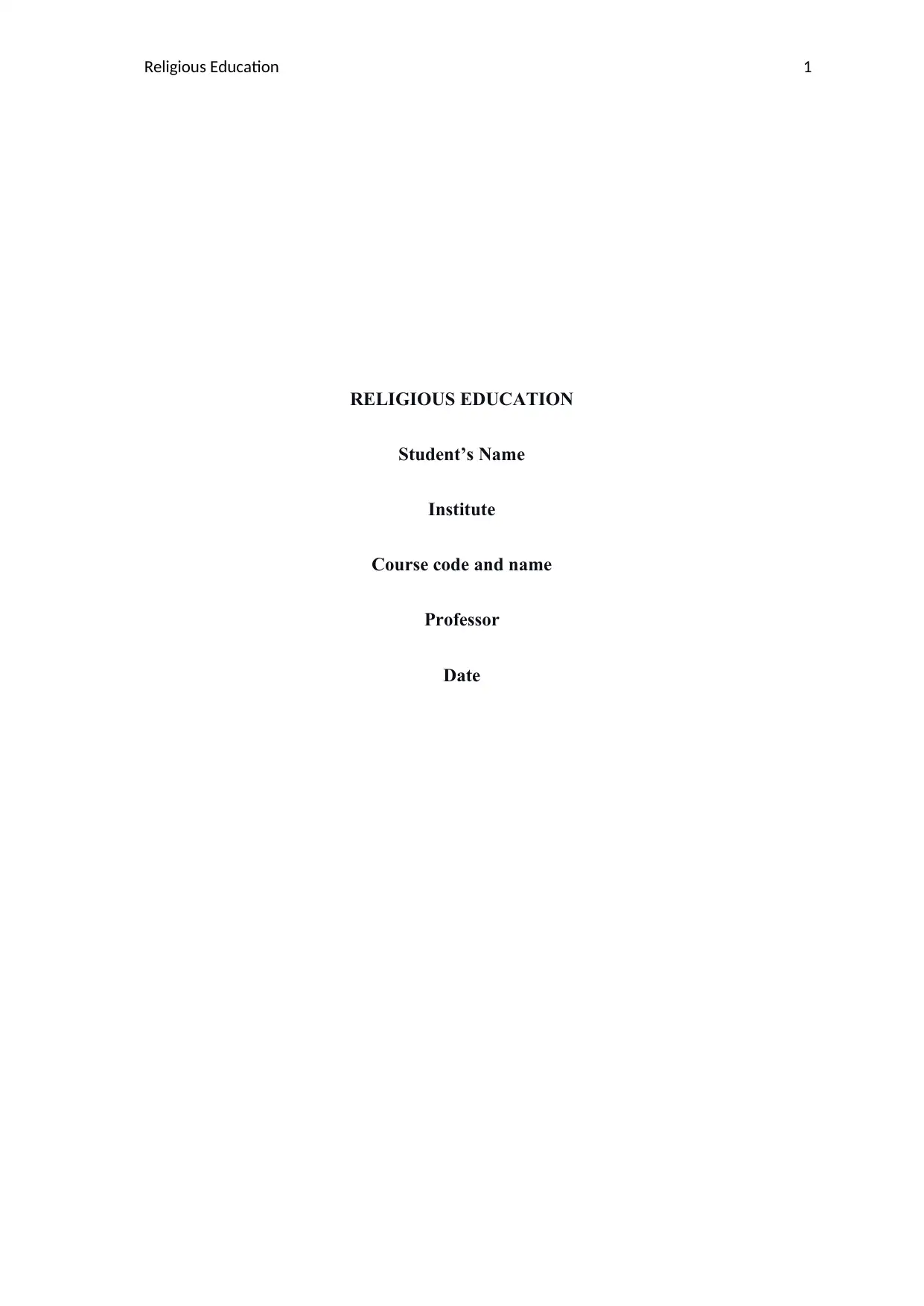
Religious Education 1
RELIGIOUS EDUCATION
Student’s Name
Institute
Course code and name
Professor
Date
RELIGIOUS EDUCATION
Student’s Name
Institute
Course code and name
Professor
Date
Paraphrase This Document
Need a fresh take? Get an instant paraphrase of this document with our AI Paraphraser
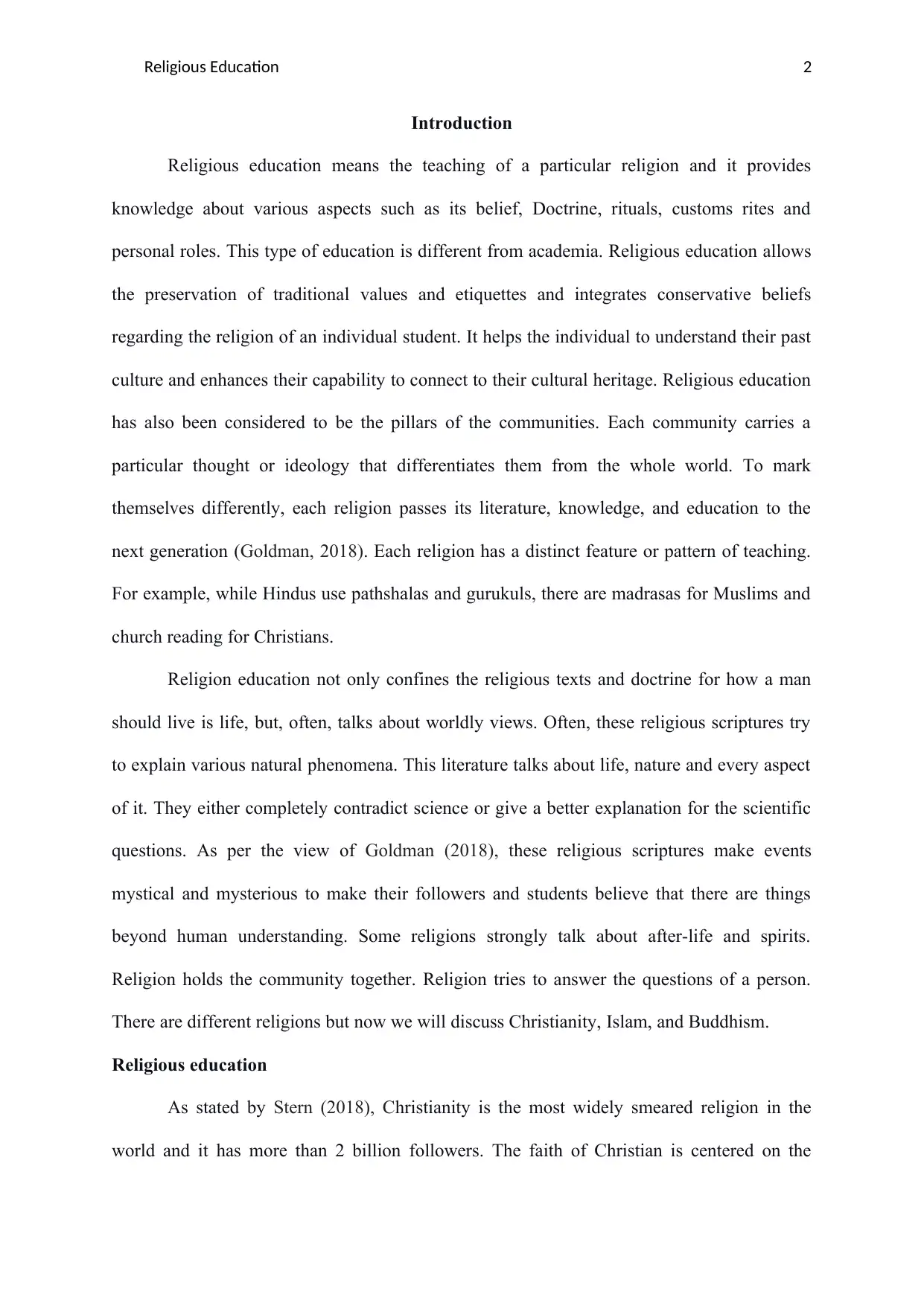
Religious Education 2
Introduction
Religious education means the teaching of a particular religion and it provides
knowledge about various aspects such as its belief, Doctrine, rituals, customs rites and
personal roles. This type of education is different from academia. Religious education allows
the preservation of traditional values and etiquettes and integrates conservative beliefs
regarding the religion of an individual student. It helps the individual to understand their past
culture and enhances their capability to connect to their cultural heritage. Religious education
has also been considered to be the pillars of the communities. Each community carries a
particular thought or ideology that differentiates them from the whole world. To mark
themselves differently, each religion passes its literature, knowledge, and education to the
next generation (Goldman, 2018). Each religion has a distinct feature or pattern of teaching.
For example, while Hindus use pathshalas and gurukuls, there are madrasas for Muslims and
church reading for Christians.
Religion education not only confines the religious texts and doctrine for how a man
should live is life, but, often, talks about worldly views. Often, these religious scriptures try
to explain various natural phenomena. This literature talks about life, nature and every aspect
of it. They either completely contradict science or give a better explanation for the scientific
questions. As per the view of Goldman (2018), these religious scriptures make events
mystical and mysterious to make their followers and students believe that there are things
beyond human understanding. Some religions strongly talk about after-life and spirits.
Religion holds the community together. Religion tries to answer the questions of a person.
There are different religions but now we will discuss Christianity, Islam, and Buddhism.
Religious education
As stated by Stern (2018), Christianity is the most widely smeared religion in the
world and it has more than 2 billion followers. The faith of Christian is centered on the
Introduction
Religious education means the teaching of a particular religion and it provides
knowledge about various aspects such as its belief, Doctrine, rituals, customs rites and
personal roles. This type of education is different from academia. Religious education allows
the preservation of traditional values and etiquettes and integrates conservative beliefs
regarding the religion of an individual student. It helps the individual to understand their past
culture and enhances their capability to connect to their cultural heritage. Religious education
has also been considered to be the pillars of the communities. Each community carries a
particular thought or ideology that differentiates them from the whole world. To mark
themselves differently, each religion passes its literature, knowledge, and education to the
next generation (Goldman, 2018). Each religion has a distinct feature or pattern of teaching.
For example, while Hindus use pathshalas and gurukuls, there are madrasas for Muslims and
church reading for Christians.
Religion education not only confines the religious texts and doctrine for how a man
should live is life, but, often, talks about worldly views. Often, these religious scriptures try
to explain various natural phenomena. This literature talks about life, nature and every aspect
of it. They either completely contradict science or give a better explanation for the scientific
questions. As per the view of Goldman (2018), these religious scriptures make events
mystical and mysterious to make their followers and students believe that there are things
beyond human understanding. Some religions strongly talk about after-life and spirits.
Religion holds the community together. Religion tries to answer the questions of a person.
There are different religions but now we will discuss Christianity, Islam, and Buddhism.
Religious education
As stated by Stern (2018), Christianity is the most widely smeared religion in the
world and it has more than 2 billion followers. The faith of Christian is centered on the
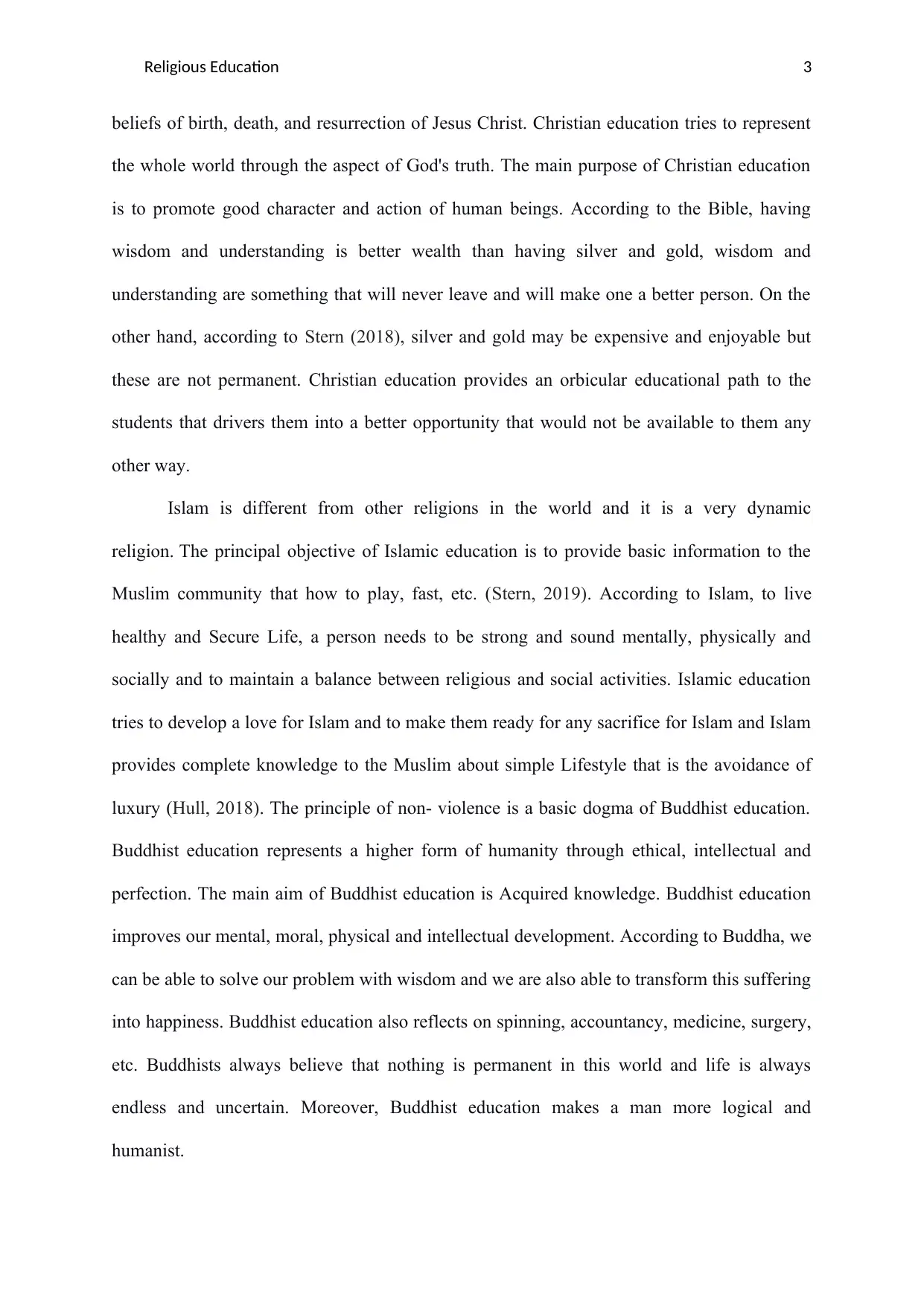
Religious Education 3
beliefs of birth, death, and resurrection of Jesus Christ. Christian education tries to represent
the whole world through the aspect of God's truth. The main purpose of Christian education
is to promote good character and action of human beings. According to the Bible, having
wisdom and understanding is better wealth than having silver and gold, wisdom and
understanding are something that will never leave and will make one a better person. On the
other hand, according to Stern (2018), silver and gold may be expensive and enjoyable but
these are not permanent. Christian education provides an orbicular educational path to the
students that drivers them into a better opportunity that would not be available to them any
other way.
Islam is different from other religions in the world and it is a very dynamic
religion. The principal objective of Islamic education is to provide basic information to the
Muslim community that how to play, fast, etc. (Stern, 2019). According to Islam, to live
healthy and Secure Life, a person needs to be strong and sound mentally, physically and
socially and to maintain a balance between religious and social activities. Islamic education
tries to develop a love for Islam and to make them ready for any sacrifice for Islam and Islam
provides complete knowledge to the Muslim about simple Lifestyle that is the avoidance of
luxury (Hull, 2018). The principle of non- violence is a basic dogma of Buddhist education.
Buddhist education represents a higher form of humanity through ethical, intellectual and
perfection. The main aim of Buddhist education is Acquired knowledge. Buddhist education
improves our mental, moral, physical and intellectual development. According to Buddha, we
can be able to solve our problem with wisdom and we are also able to transform this suffering
into happiness. Buddhist education also reflects on spinning, accountancy, medicine, surgery,
etc. Buddhists always believe that nothing is permanent in this world and life is always
endless and uncertain. Moreover, Buddhist education makes a man more logical and
humanist.
beliefs of birth, death, and resurrection of Jesus Christ. Christian education tries to represent
the whole world through the aspect of God's truth. The main purpose of Christian education
is to promote good character and action of human beings. According to the Bible, having
wisdom and understanding is better wealth than having silver and gold, wisdom and
understanding are something that will never leave and will make one a better person. On the
other hand, according to Stern (2018), silver and gold may be expensive and enjoyable but
these are not permanent. Christian education provides an orbicular educational path to the
students that drivers them into a better opportunity that would not be available to them any
other way.
Islam is different from other religions in the world and it is a very dynamic
religion. The principal objective of Islamic education is to provide basic information to the
Muslim community that how to play, fast, etc. (Stern, 2019). According to Islam, to live
healthy and Secure Life, a person needs to be strong and sound mentally, physically and
socially and to maintain a balance between religious and social activities. Islamic education
tries to develop a love for Islam and to make them ready for any sacrifice for Islam and Islam
provides complete knowledge to the Muslim about simple Lifestyle that is the avoidance of
luxury (Hull, 2018). The principle of non- violence is a basic dogma of Buddhist education.
Buddhist education represents a higher form of humanity through ethical, intellectual and
perfection. The main aim of Buddhist education is Acquired knowledge. Buddhist education
improves our mental, moral, physical and intellectual development. According to Buddha, we
can be able to solve our problem with wisdom and we are also able to transform this suffering
into happiness. Buddhist education also reflects on spinning, accountancy, medicine, surgery,
etc. Buddhists always believe that nothing is permanent in this world and life is always
endless and uncertain. Moreover, Buddhist education makes a man more logical and
humanist.
⊘ This is a preview!⊘
Do you want full access?
Subscribe today to unlock all pages.

Trusted by 1+ million students worldwide
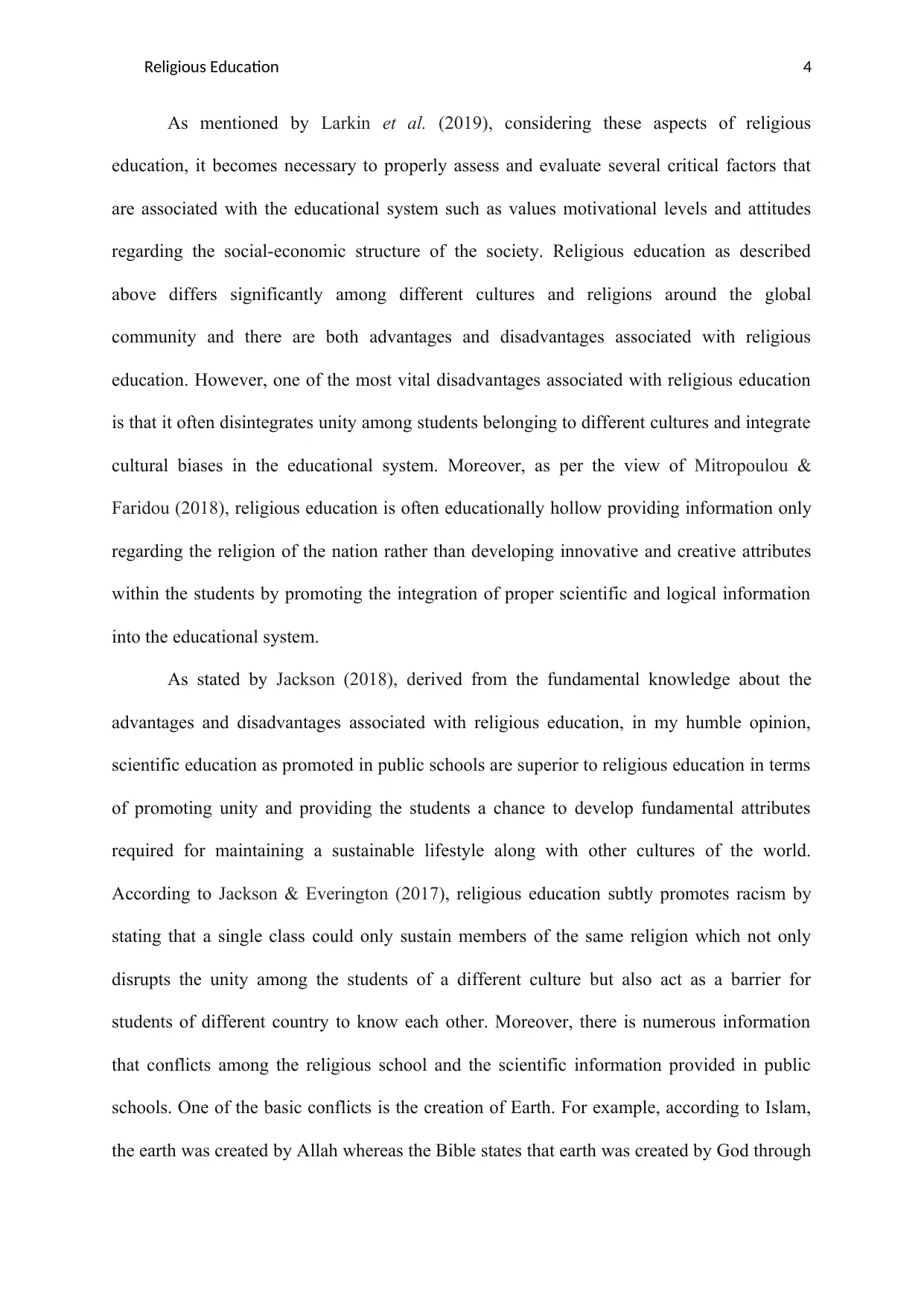
Religious Education 4
As mentioned by Larkin et al. (2019), considering these aspects of religious
education, it becomes necessary to properly assess and evaluate several critical factors that
are associated with the educational system such as values motivational levels and attitudes
regarding the social-economic structure of the society. Religious education as described
above differs significantly among different cultures and religions around the global
community and there are both advantages and disadvantages associated with religious
education. However, one of the most vital disadvantages associated with religious education
is that it often disintegrates unity among students belonging to different cultures and integrate
cultural biases in the educational system. Moreover, as per the view of Mitropoulou &
Faridou (2018), religious education is often educationally hollow providing information only
regarding the religion of the nation rather than developing innovative and creative attributes
within the students by promoting the integration of proper scientific and logical information
into the educational system.
As stated by Jackson (2018), derived from the fundamental knowledge about the
advantages and disadvantages associated with religious education, in my humble opinion,
scientific education as promoted in public schools are superior to religious education in terms
of promoting unity and providing the students a chance to develop fundamental attributes
required for maintaining a sustainable lifestyle along with other cultures of the world.
According to Jackson & Everington (2017), religious education subtly promotes racism by
stating that a single class could only sustain members of the same religion which not only
disrupts the unity among the students of a different culture but also act as a barrier for
students of different country to know each other. Moreover, there is numerous information
that conflicts among the religious school and the scientific information provided in public
schools. One of the basic conflicts is the creation of Earth. For example, according to Islam,
the earth was created by Allah whereas the Bible states that earth was created by God through
As mentioned by Larkin et al. (2019), considering these aspects of religious
education, it becomes necessary to properly assess and evaluate several critical factors that
are associated with the educational system such as values motivational levels and attitudes
regarding the social-economic structure of the society. Religious education as described
above differs significantly among different cultures and religions around the global
community and there are both advantages and disadvantages associated with religious
education. However, one of the most vital disadvantages associated with religious education
is that it often disintegrates unity among students belonging to different cultures and integrate
cultural biases in the educational system. Moreover, as per the view of Mitropoulou &
Faridou (2018), religious education is often educationally hollow providing information only
regarding the religion of the nation rather than developing innovative and creative attributes
within the students by promoting the integration of proper scientific and logical information
into the educational system.
As stated by Jackson (2018), derived from the fundamental knowledge about the
advantages and disadvantages associated with religious education, in my humble opinion,
scientific education as promoted in public schools are superior to religious education in terms
of promoting unity and providing the students a chance to develop fundamental attributes
required for maintaining a sustainable lifestyle along with other cultures of the world.
According to Jackson & Everington (2017), religious education subtly promotes racism by
stating that a single class could only sustain members of the same religion which not only
disrupts the unity among the students of a different culture but also act as a barrier for
students of different country to know each other. Moreover, there is numerous information
that conflicts among the religious school and the scientific information provided in public
schools. One of the basic conflicts is the creation of Earth. For example, according to Islam,
the earth was created by Allah whereas the Bible states that earth was created by God through
Paraphrase This Document
Need a fresh take? Get an instant paraphrase of this document with our AI Paraphraser

Religious Education 5
his powers. As mentioned by Berglund, Shanneik & Bocking (2016), this information starkly
contradicts the scientific data regarding the explosion of after creating the solar system.
Nonetheless, we cannot neglect the importance of religion in developing model’s ethics and
basic cultural knowledge among the students, especially at a young age. Although, the
majority of religious data is built on a superstitious infrastructure supported by authoritarian
power, i.e. God, of different religion, the lies a basic structure which is filled with morals and
ethical values that are extremely important for the student’s upbringing.
As mentioned by Arold, Woessmann & Zierow (2019), the values and beliefs that are
integrated into religious schools help the students to develop ethical attributes and become
better human beings promoting them to be self-sacrifice and pro-family. They are taught how
to promote and carry their religious values from one generation to another. But often these
strong believes create commotion within the community or among the communities. One
religion feeling superior to every other religion influence violence and rage. The students and
followers of the religion become blind to the religious believes and try to impose their
religious learnings on every other human being (Kallioniemi, & Ubani, 2016). They have this
feeling that people of other beliefs are wrong and it is their responsibility that they show them
the correct path. However, this toxic religious belief has often caused more damage than
good. It spreads more hatred within society. Often these strong believes can ruin generations
of ideologies and make them hate other people.
Religious education also includes scriptures written by saints and knowledgeable
people about life and nature. These texts include information and understanding of life came
into existence, how the earth was created and everything is what it is (Knauth & Vieregge,
2018). It tries to give perspective and reason for everything. They also try to explain various
phenomena through spiritual and supernatural causes. However, this kind of education also
blocks the student from developing scientific ideas based on logical data and think out of the
his powers. As mentioned by Berglund, Shanneik & Bocking (2016), this information starkly
contradicts the scientific data regarding the explosion of after creating the solar system.
Nonetheless, we cannot neglect the importance of religion in developing model’s ethics and
basic cultural knowledge among the students, especially at a young age. Although, the
majority of religious data is built on a superstitious infrastructure supported by authoritarian
power, i.e. God, of different religion, the lies a basic structure which is filled with morals and
ethical values that are extremely important for the student’s upbringing.
As mentioned by Arold, Woessmann & Zierow (2019), the values and beliefs that are
integrated into religious schools help the students to develop ethical attributes and become
better human beings promoting them to be self-sacrifice and pro-family. They are taught how
to promote and carry their religious values from one generation to another. But often these
strong believes create commotion within the community or among the communities. One
religion feeling superior to every other religion influence violence and rage. The students and
followers of the religion become blind to the religious believes and try to impose their
religious learnings on every other human being (Kallioniemi, & Ubani, 2016). They have this
feeling that people of other beliefs are wrong and it is their responsibility that they show them
the correct path. However, this toxic religious belief has often caused more damage than
good. It spreads more hatred within society. Often these strong believes can ruin generations
of ideologies and make them hate other people.
Religious education also includes scriptures written by saints and knowledgeable
people about life and nature. These texts include information and understanding of life came
into existence, how the earth was created and everything is what it is (Knauth & Vieregge,
2018). It tries to give perspective and reason for everything. They also try to explain various
phenomena through spiritual and supernatural causes. However, this kind of education also
blocks the student from developing scientific ideas based on logical data and think out of the
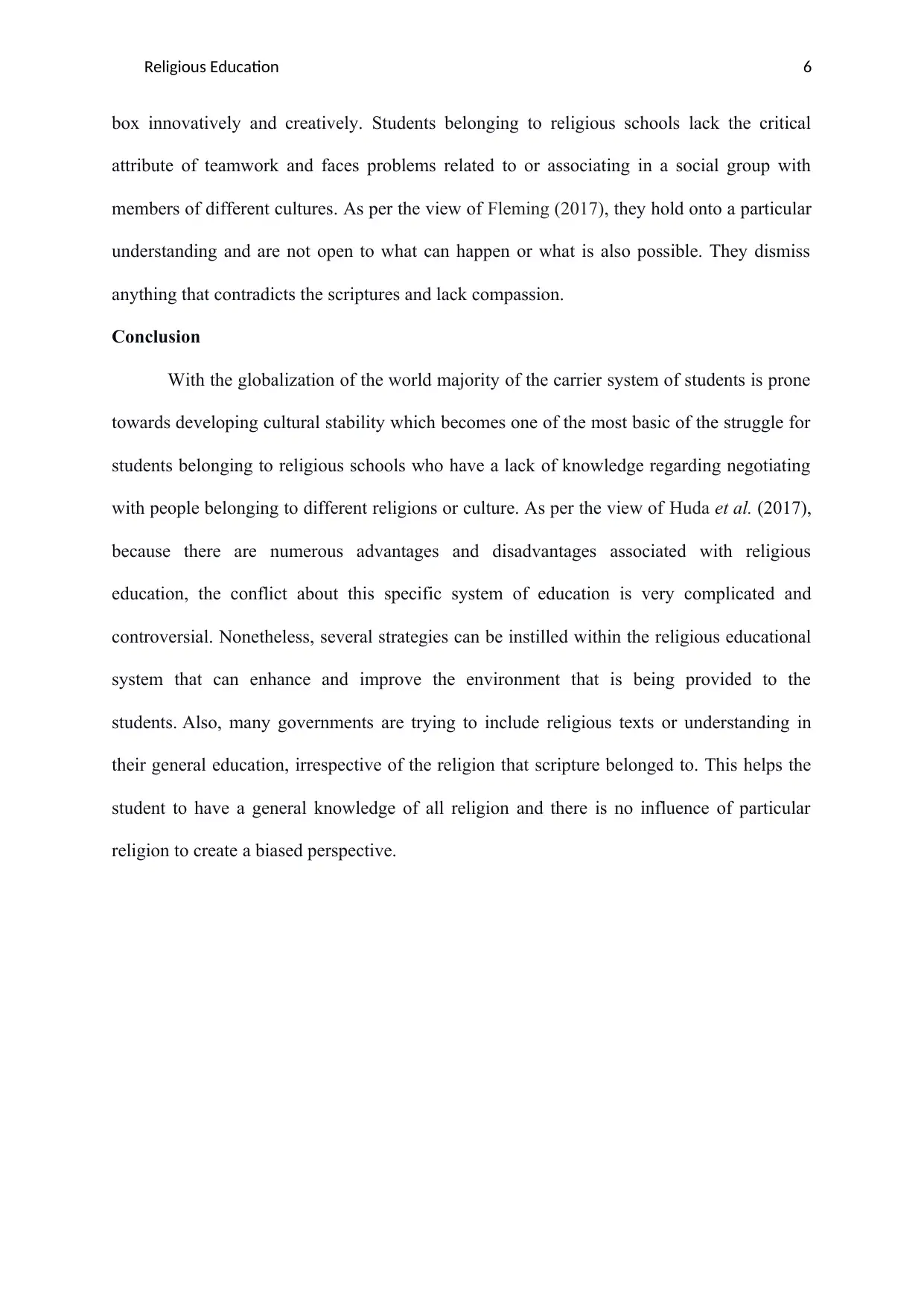
Religious Education 6
box innovatively and creatively. Students belonging to religious schools lack the critical
attribute of teamwork and faces problems related to or associating in a social group with
members of different cultures. As per the view of Fleming (2017), they hold onto a particular
understanding and are not open to what can happen or what is also possible. They dismiss
anything that contradicts the scriptures and lack compassion.
Conclusion
With the globalization of the world majority of the carrier system of students is prone
towards developing cultural stability which becomes one of the most basic of the struggle for
students belonging to religious schools who have a lack of knowledge regarding negotiating
with people belonging to different religions or culture. As per the view of Huda et al. (2017),
because there are numerous advantages and disadvantages associated with religious
education, the conflict about this specific system of education is very complicated and
controversial. Nonetheless, several strategies can be instilled within the religious educational
system that can enhance and improve the environment that is being provided to the
students. Also, many governments are trying to include religious texts or understanding in
their general education, irrespective of the religion that scripture belonged to. This helps the
student to have a general knowledge of all religion and there is no influence of particular
religion to create a biased perspective.
box innovatively and creatively. Students belonging to religious schools lack the critical
attribute of teamwork and faces problems related to or associating in a social group with
members of different cultures. As per the view of Fleming (2017), they hold onto a particular
understanding and are not open to what can happen or what is also possible. They dismiss
anything that contradicts the scriptures and lack compassion.
Conclusion
With the globalization of the world majority of the carrier system of students is prone
towards developing cultural stability which becomes one of the most basic of the struggle for
students belonging to religious schools who have a lack of knowledge regarding negotiating
with people belonging to different religions or culture. As per the view of Huda et al. (2017),
because there are numerous advantages and disadvantages associated with religious
education, the conflict about this specific system of education is very complicated and
controversial. Nonetheless, several strategies can be instilled within the religious educational
system that can enhance and improve the environment that is being provided to the
students. Also, many governments are trying to include religious texts or understanding in
their general education, irrespective of the religion that scripture belonged to. This helps the
student to have a general knowledge of all religion and there is no influence of particular
religion to create a biased perspective.
⊘ This is a preview!⊘
Do you want full access?
Subscribe today to unlock all pages.

Trusted by 1+ million students worldwide

Religious Education 7
Reference
Arold, B., Woessmann, L., & Zierow, L. (2019). Can Schools Change Religious Attitudes?
Evidence from German State Reforms of Compulsory Religious Education.
Berglund, J., Shanneik, Y., & Bocking, B. (Eds.). (2016). Religious education in a global-
local world (Vol. 4). Springer.
Fleming, D. J. (2017). The Enduring Contribution of Religious Education to Reason’s Good
Functioning. Value Learning Trajectories: Theory, Method, Context, 31.
Goldman, R. (2018). Readiness for religion: A basis for developmental religious
education (Vol. 5). Routledge.
Huda, M., Jasmi, K. A., Mustari, M. I. B., & Basiron, A. B. (2017). Understanding of
Wara’(Godliness) as a Feature of Character and Religious Education. The Social
Sciences, 12(6), 1106-1111.
Hull, J. (Ed.). (2018). New directions in religious education (Vol. 7). Routledge.
Jackson, R. (2018). Religious education for plural societies: The selected works of Robert
Jackson. Routledge.
Jackson, R., & Everington, J. (2017). Teaching inclusive religious education impartially: An
English perspective. British Journal of Religious Education, 39(1), 7-24.
Kallioniemi, A., & Ubani, M. (2016). Religious education in the Finnish school system.
In Miracle of Education (pp. 179-190). Brill Sense.
Knauth, T., & Vieregge, D. (2018). Religious Diversity and Dialogue in Religious
Education. Religion and Dialogue in the City: Case Studies on Interreligious
Encounter in Urban Community and Education, 183.
Larkin, S., Freathy, R., Doney, J., & Freathy, G. (2019). Metacognition, Worldviews and
Religious Education: A Practical Guide for Teachers. Routledge.
Reference
Arold, B., Woessmann, L., & Zierow, L. (2019). Can Schools Change Religious Attitudes?
Evidence from German State Reforms of Compulsory Religious Education.
Berglund, J., Shanneik, Y., & Bocking, B. (Eds.). (2016). Religious education in a global-
local world (Vol. 4). Springer.
Fleming, D. J. (2017). The Enduring Contribution of Religious Education to Reason’s Good
Functioning. Value Learning Trajectories: Theory, Method, Context, 31.
Goldman, R. (2018). Readiness for religion: A basis for developmental religious
education (Vol. 5). Routledge.
Huda, M., Jasmi, K. A., Mustari, M. I. B., & Basiron, A. B. (2017). Understanding of
Wara’(Godliness) as a Feature of Character and Religious Education. The Social
Sciences, 12(6), 1106-1111.
Hull, J. (Ed.). (2018). New directions in religious education (Vol. 7). Routledge.
Jackson, R. (2018). Religious education for plural societies: The selected works of Robert
Jackson. Routledge.
Jackson, R., & Everington, J. (2017). Teaching inclusive religious education impartially: An
English perspective. British Journal of Religious Education, 39(1), 7-24.
Kallioniemi, A., & Ubani, M. (2016). Religious education in the Finnish school system.
In Miracle of Education (pp. 179-190). Brill Sense.
Knauth, T., & Vieregge, D. (2018). Religious Diversity and Dialogue in Religious
Education. Religion and Dialogue in the City: Case Studies on Interreligious
Encounter in Urban Community and Education, 183.
Larkin, S., Freathy, R., Doney, J., & Freathy, G. (2019). Metacognition, Worldviews and
Religious Education: A Practical Guide for Teachers. Routledge.
Paraphrase This Document
Need a fresh take? Get an instant paraphrase of this document with our AI Paraphraser
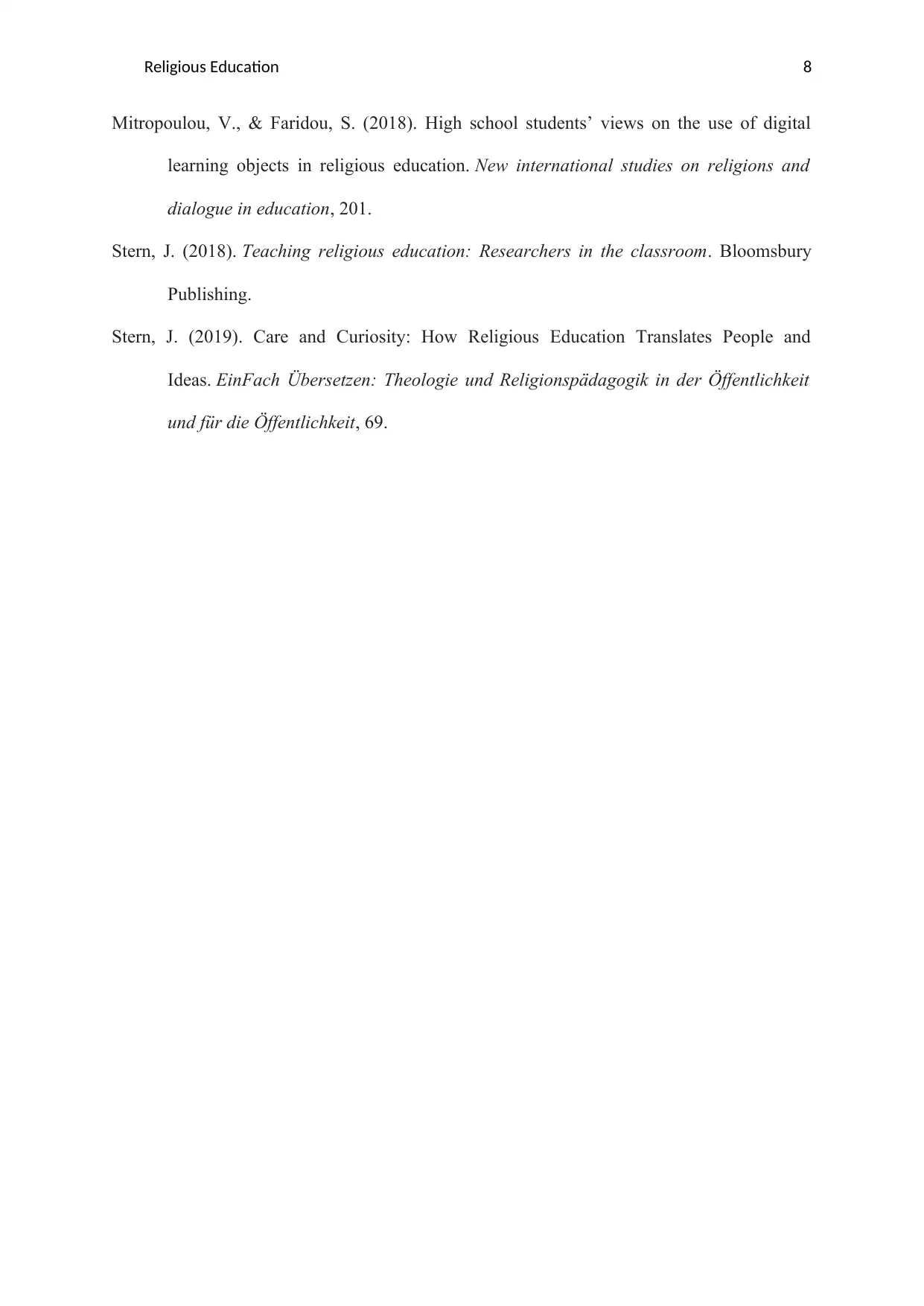
Religious Education 8
Mitropoulou, V., & Faridou, S. (2018). High school students’ views on the use of digital
learning objects in religious education. New international studies on religions and
dialogue in education, 201.
Stern, J. (2018). Teaching religious education: Researchers in the classroom. Bloomsbury
Publishing.
Stern, J. (2019). Care and Curiosity: How Religious Education Translates People and
Ideas. EinFach Übersetzen: Theologie und Religionspädagogik in der Öffentlichkeit
und für die Öffentlichkeit, 69.
Mitropoulou, V., & Faridou, S. (2018). High school students’ views on the use of digital
learning objects in religious education. New international studies on religions and
dialogue in education, 201.
Stern, J. (2018). Teaching religious education: Researchers in the classroom. Bloomsbury
Publishing.
Stern, J. (2019). Care and Curiosity: How Religious Education Translates People and
Ideas. EinFach Übersetzen: Theologie und Religionspädagogik in der Öffentlichkeit
und für die Öffentlichkeit, 69.
1 out of 8
Related Documents
Your All-in-One AI-Powered Toolkit for Academic Success.
+13062052269
info@desklib.com
Available 24*7 on WhatsApp / Email
![[object Object]](/_next/static/media/star-bottom.7253800d.svg)
Unlock your academic potential
Copyright © 2020–2025 A2Z Services. All Rights Reserved. Developed and managed by ZUCOL.





